Fun in the sun! Take your dog to the beach with these important tips
The summer weather is a perfect time to take your dog and family to the nearest lake or the beach. But to make your day with your pet is a relaxing experience, there are a few things you should keep in mind.
Are dogs allowed on your beach?
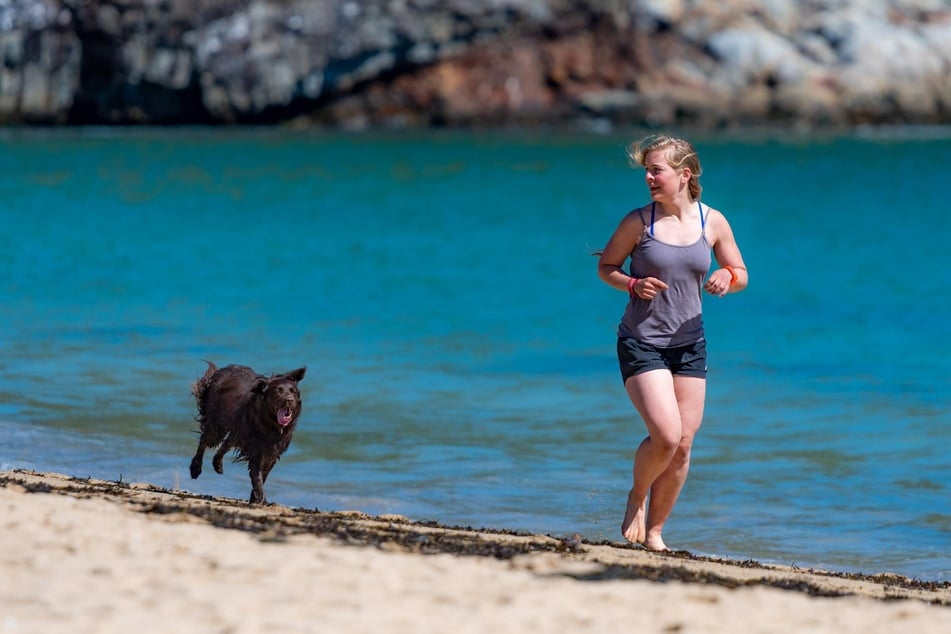
Most lakes and ponds actually have some type of regulation, posted or not, about whether dogs are allowed.
In order to avoid headaches upon arrival, take the time to find out if dogs are actually allowed at your destination.
Remember, just because you see others posting pictures on Instagram of their dogs in tagged locations doesn't mean they are actually allowed to be there.
For areas within national parks, the National Parks Service operates webpages with updated alerts on whether wildlife has been spotted in the area, or if you need to be wary of environmental concerns such as algae blooms, which can be fatal to dogs.
Websites like BringFido.com can also help you find just the right beach for your next day out.
However, even if a beach or lakeside says dogs are allowed, it might not mean your dog can just roam freely once you arrive.
Some locations do have leash laws, requiring your dog to be with you at all times. This has to do with the safety of visitors, as well as helping prevent damage to the environment. In areas where sea turtles nest, for example, dogs absolutely can't be allowed to dig and disturb endangered species.
You also need to be aware of how far you travel away from where you entered the beach. In many cases, you may risk entering private beach area owned by resorts or individuals, and you could be trespassing. Even if those private beaches are open to the public, they may enforce their own rules about dogs.
Always be on the lookout for signs that can give you more information about a particular beach, especially if there are dangers in the water that could harm a dog who likes to swim.
Which beaches are suitable for dogs?
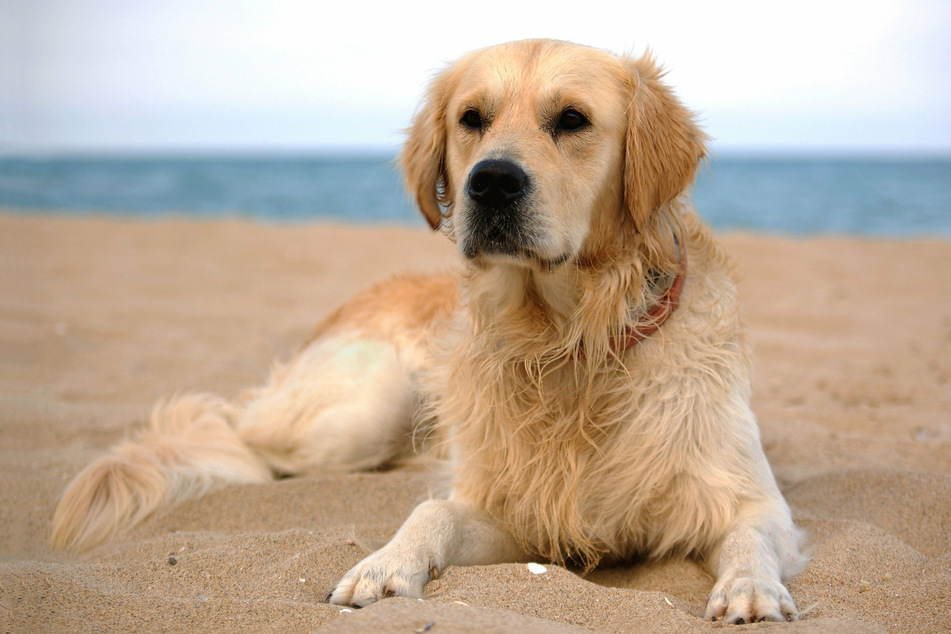
Apart from the fact that dogs should preferably only be on beaches where they're permitted, not every beach is necessarily suitable for a vacation with a pup.
For dogs, just like for humans, sandy beaches are the most pleasant choice. They can run comfortably on smooth sand without hurting themselves. However, dog owners should make sure that their four-legged friend avoids running over hot sand, because their paws could potentially burn and blister, just as on hot asphalt.
Pebble beaches are only suitable for dogs to a limited extent. There is a risk of sharp stones drilling into the paws and causing injuries, which would be a painful interruption to a fun day. Depending on how large the pebbles are, dogs sometimes find it difficult to maintain traction while walking and can be at risk for slipping or spraining a joint.
You should also look for beaches that allow dogs to get in and out of the water easily – so rocky beaches with higher cliffs are usually also unsuitable for dogs.
What to consider before going to the beach with a dog
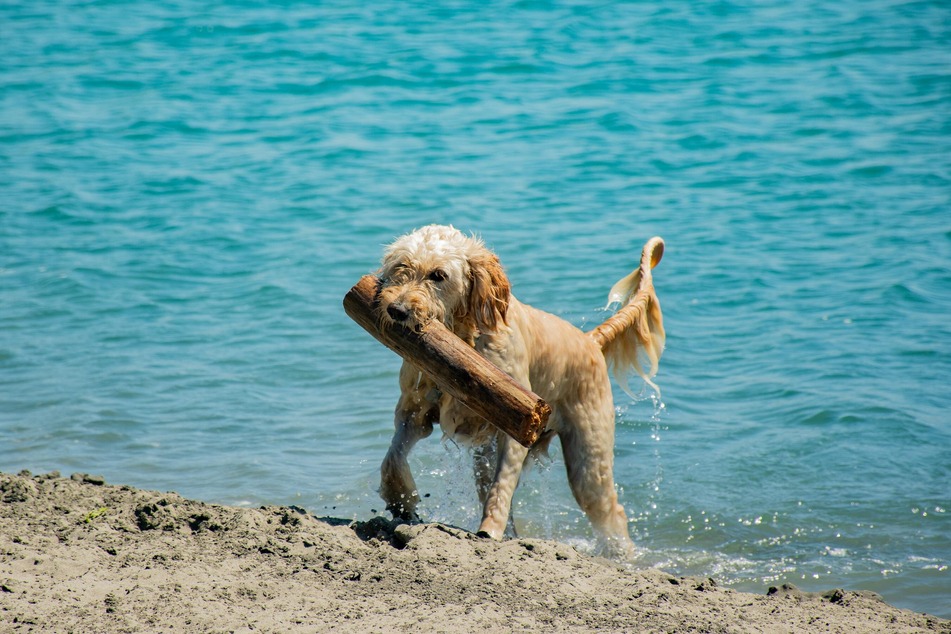
Ideally, any dog you are considering taking to the beach should be in good shape and healthy.
However, if you want to go on a trip with a senior dog or one with pre-existing conditions, you should plan more carefully. After all, you don't want to overtax your faithful companion.
Choose a day that isn't sweltering hot, as higher temperatures can pose unnecessary risk to a dog's circulatory system if they can't easily keep cool.
To prepare yourself and your dog for the beach, avoid giving your pooch large amounts of food immediately prior. A fuller stomach can increase the risk of getting twisted while the dog romps around in the sand or water.
Do however, be sure to give them plenty of water to drink in advance, as they can quickly become dehydrated in direct sun.
When packing your beach bag, you should also think about your dog. In addition to your own swimsuit, towel, and sunscreen, be sure to remember sufficient drinking water and a first aid kit in order to be able to treat minor injuries quickly on site. If you are planning to spend the whole day at the lake or sea, it is a good idea to take a full dog meal with you.
Make sure to add these to your checklist of the most important items for your dog at the beach: fresh drinking water and a water bowl, a collar and leash, dog waste bags, suitable toys like a Frisbee or balls, umbrella or other shade, treats or extra food, and special sun cream for sun-sensitive dogs.
Protect dogs from sunburn on the beach
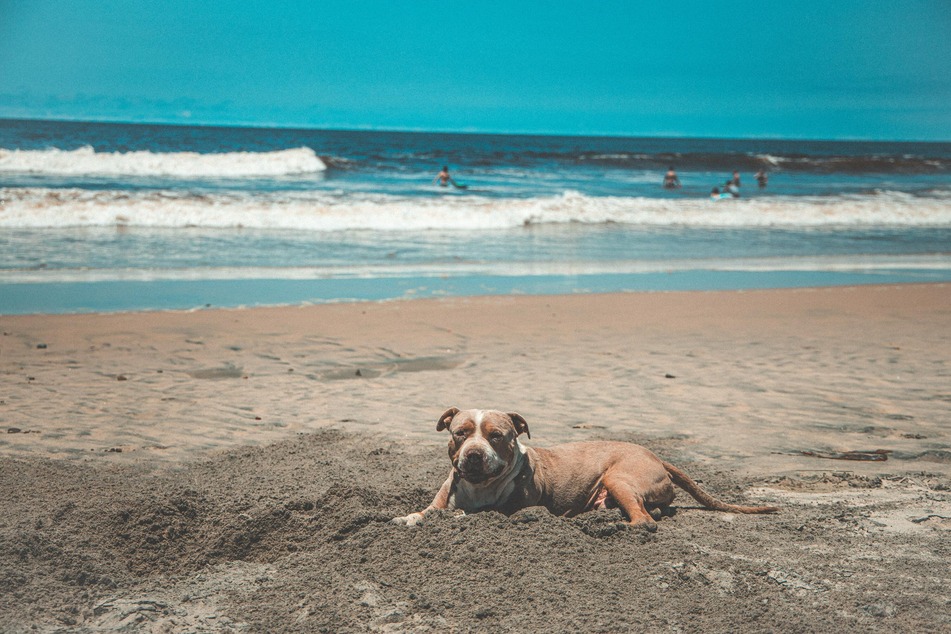
Many dog owners are not aware that their pet can also get sunburned.
Dogs with thin, short fur and light skin are particularly at risk, as are any dogs with patches of thinner hair. On most dogs, areas like the tips and insides of the ears, the bridge of the nose, and the belly, are particularly vulnerable to sunburn.
There is also the danger of heat stroke while playing in the blazing sun, which can lead to serious organ damage and even death in both dogs and humans.
For this reason, dogs and their owners should have shade available at all times. A large umbrella, a tent, or a nearby tree will do the job.
You'll need wet towels available to promote cooling even in the shade, as dogs are only able to cool down through panting, and cannot sweat.
If you want to get active with your four-legged friend, take dog walks best in the morning or early evening, when the temperatures have already cooled down a bit.
What you need to remember when swimming with a dog
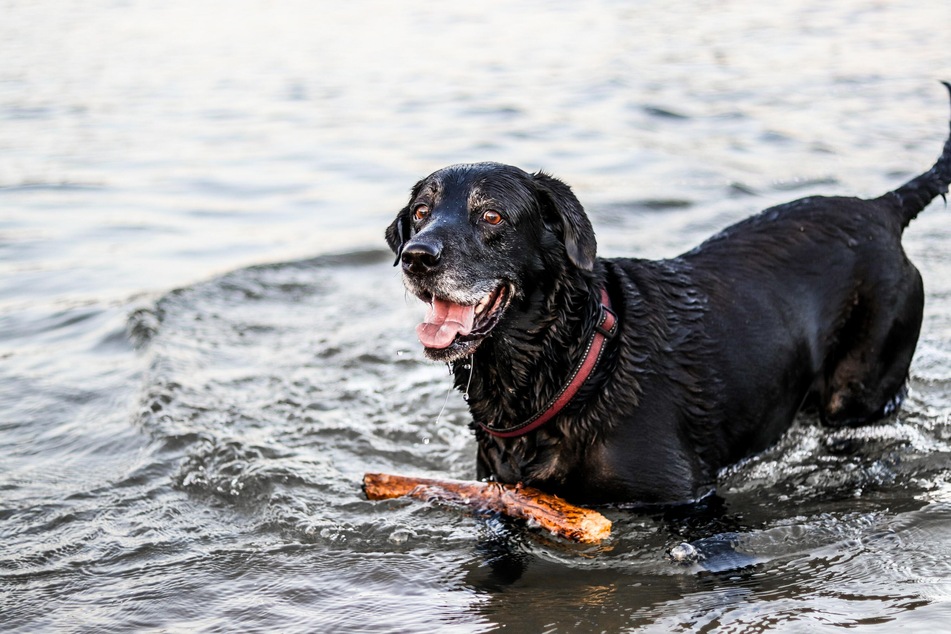
Not every dog is destined to love water. Though there are some who leap into the water the first chance they get, others may not even want to dip their toes in!
This also depends a lot on the breed of dog, as some inherently swim well and retrieve from the water, while others don't have this tendency.
The most important thing is to accept when your dog does not want to go into the water. If you're determined to get your dog into the water to cool off, you'll need to proceed patiently.
The best place to start is in shallow water that is as warm as possible, choosing a small bank or stream so that your dog learns what the water feels like and how to get out easily.
Also, be careful that your dog doesn't swallow too much salt water. If they seem to be doing so, whether they are playing or actually thirsty, make sure to provide fresh water and take breaks more often.
When dogs start showing signs of fatigue, it is time to get them out of the water.
Furthermore, you should pay attention when swimming to avoid moorings for boats and fishing spots. Also, do not encourage your dog to swim in strong currents or high waves – and make sure they always stay close to the shore.
What to look out for after a day at the beach
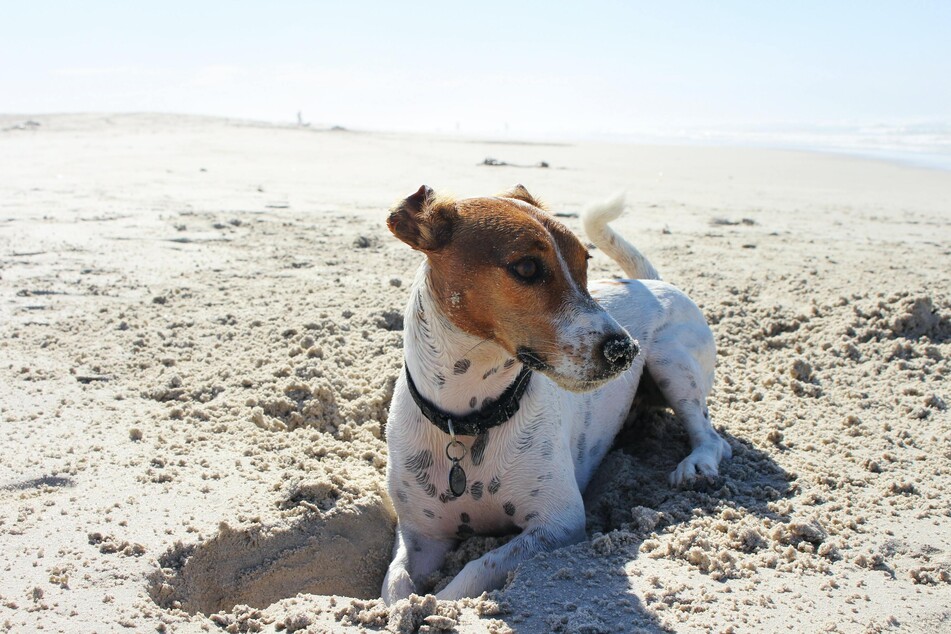
After a busy day at the beach, give your dog a good rinse-off to remove sand, debris, and anything that could be trapped under the fur next to the skin.
There are often dead fish or birds at the beach that dogs love to roll in, so a bath is definitely a good idea.
Be sure to dry their fur thoroughly, particularly if there is a chilly wind or it is overcast. Dogs with a double-coat have a harder time drying off and are also at a greater risk for hypothermia in these conditions.
Offer your furry friend fresh drinking water to quench their thirst.
And after all of that fresh beach exercise, your hound deserves a good meal to cap off a fun day.
Correct behavior at the beach
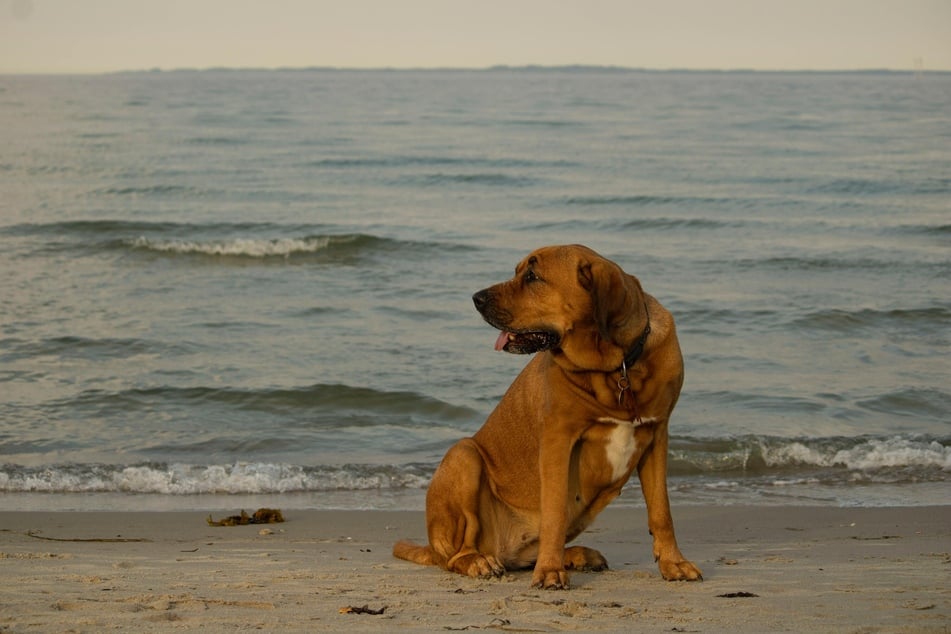
Finally, there are some tips on proper beach etiquette for dogs, because its rarely a good idea to just let your dog frolic with no restraint.
Always collect your dog's waste immediately. Take sufficient disposable bags with you for this purpose.
Don't let your dog run over to other dogs. First, ask their owners, and only let the furry pals play with each other after they have given their permission.
If your dog has a strong hunting instinct or tends to eat trash or roll in anything stinky, be sure to keep them leashed, because a beach presents plenty of opportunities to get into mischief.
Keep your distance to other beach visitors as well as to boats, jet skis, and similar watercraft. Not only can dogs become frightened and take off running, but not everyone at the beach feels safe around unfamiliar animals, especially when they bring little children with them.
As you prepare for your day relaxing at the beach with your dog, remember to answer the most important questions ahead of time: Does my beach allow dogs? What do I need to pack for my dog to have a great time? How many hours will we spend outside in the sun?
If you prepare well, you're sure to have a wonderful day making memories with your best friend.
Cover photo: Unsplash/Luis Lara

